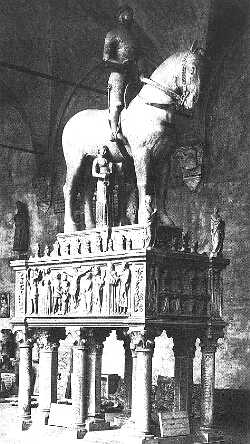
The equestrian statue of Bernabo Visconti in the Castello
Sforzesco in Milan
|
The reign of Matteo Visconti was a particularly prosperous period, during which Milan experienced great commercial expansion in Piacenza, Bergamo, Como, Cremona, Alessandria, Tortona, Pavia, Vercelli and Novara. Although he was not such a skilled diplomat as his father had been, Matteo Visconti's successor Galeazzo, 1st duke of Milan, who had already been collaborating with his father as 'Capitano del Popolo', continued to rule over the new lands, which he gave to his son Azzone. According to the chronicles of that era, Azzone Visconti took power in Lodi and Brescia. He consolidated the state, made peace with the pope, and increased the Milanese territories. Milan's culture and art prospered under Azzone. In fact, he boosted economy with the building of bridges, markets, sewers, and paved streets. He had the city walls and gates enhanced with defensive elements, as well as with sculptures by the Tuscan artist Giovanni di Balduccio, while Giotto was called in to paint the frescos inside the Ducal Residence. At his untimely death, his two uncles, Luchino and Giovanni, were proclaimed dukes.
Matteo's grandson Bernabo Visconti (1319-1385) was an Italian soldier and statesman. He married Regina della Scala of Verona and forged both a political and aesthetic alliance between the two cities. His intrigues and ambitions kept him at war almost continuously with Pope Urban V (who briefly excommunicated him in 1363), the Florentines, Venice and Savoy until he was deposed by his nephew Gian Galeazzo Visconti in 1385. An equestrian statue of Bernabo Visconti was made in 1363 by Bonino da Campione and now stands in the Castello Sforzesco in Milan.
In 1370, the pope sent two papal delegates to serve Bernabo his excommunication papers(consisting of a parchment bearing a leaden seal rolled in a silken cord). Bernabo, infuriated, placed the two papal delegates under arrest and refused their release until they had eaten the parchment, seal, and silken cord which they served him. His daughter Thadea Visconti married Stephen III, Duke of Bavaria. She was mother to Louis VII, Duke of Bavaria. His other daughter Maddalena Visconti married Frederick, Duke of Bavaria and was mother of Henry XVI of Bavaria.
|
(from www.croponline.org/trezzocastle.htm)
Trezzo sull’Adda’s castle rises near the shore of the Adda river, near Milan. It was built in the Longobard age and then became the residence of Federico Barbarossa and then of the Viscontis. They say that this castle hide a big treasure, belonged to Federico Barbarossa, Emperor of the Holy Roman Empire in the second half of the XII century.
There is also a story that tell that the ghosts of the Barbarossa’s army are still protecting that treasure. In this castle there are two wells. In one of them, the Viscontis threw down their enemies captured during wars or “unwelcome” guests. Others were tortured; in fact in the basement there was the “drop’s room”, which was excavated into a natural cave underlying the castle, so there are some places where drops of water fall down. The prisoners were tied down in a position where continually falling waterdroplets slowly excavate their head, causing them to suffer a slow, agonizing death.
Bernabo Visconti’s daughter was imprisoned in the castle’s dungeon because she fell in love with the stableman, who died he too trying to defend her. But here died also Bernabò Visconti himself, poisoned by Gian Galeazzo Visconti. But there are other mysteries like the skeleton of a Longobard, found by some archeologist, 2,40 meters high! He might be an important person because he had a rich funeral equipment.
|